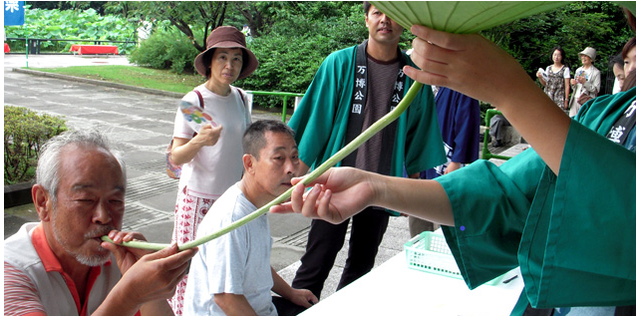Gourmand Dietary Culture
- TOP
- ESSAYS
- Gourmand Dietary Culture
- Trunk Cup
Trunk Cup
vesta No. 80
Professor Gourmand Drinking from a Trunk Cup
As someone who likes to sleep in, Professor Gourmand might be one for a morning bath, but he has a principle of not drinking alcohol first thing. Otherwise he'll become a Shosuke Ohara [a character known for drinking away his family fortune]. Principles are premised on the idea of deviant behaviour. This morning, July 4, 2010, I drank sake in the morning. More than that, I drank sake from 6 a.m.
There is a large Japanese garden in Osaka's Expo Commemoration Park, right next to my old workplace, the National Museum of Ethnology. When the flowers in the lotus pond are blooming from early to mid-July, there is always an "Early Morning Party." This morning I got up early and went to the party. I had the feeling that I'd be admired like an elegant samurai, though that wasn't my reason for going. I went in order to drink sake in the morning from a trunk cup. In the Japanese garden, beside the lotus pond, is trunk cup corner, where lotus leaves grow with long stalks. To get some sake, you put the end of the stalk in your mouth and lift the lotus leaf-end upwards like a funnel, then someone pours the sake in. The droplets of sake appear like droplets of dew on the lotus leaves, glistening in the sun. There's a little hole made where the leaf and stalk join, so if you suck, the sake travels down the stalk into your mouth. One cupful of lotus leaf is called a trunk cup.
You can use the same lotus leaf stalk any number of times, but it stays clean because you cut out the part that touches each drinker's mouth. In the "Food and Drink" chapter of Miscellaneous Morsels from Youyang, written in Tang-Dynasty China, there is the legend of the "Jade Cup" I'm going to try and explain the name.
It was in the Zhengshi Era of the Wei Kingdom, but the tricky thing is there were Wei Kingdoms both during the Three Kingdoms Period and during the North and South Period, and both Periods had Zhengshi Eras. The Zhengshi Era of the Three Kingdoms Period was roughly in the middle of the Third Century, and the Zhengshi Era of the North and South Period was roughly at the beginning of the Fifth Century. Anyway, whichever Wei Kingdom Zhengshi Era we're talking about, there was a regional general, Zheng Gongyu, who would always retire during the hottest part of the year (the dog days of summer) to the Shi Jun woods in the historic Shandong Province, along with his assistants and councillors. They would pick large lotus leaves, make holes in the middle of them with a hairpin, and then pour sake down the bent stem, like an elephant's trunk, passing the sake around. This sake cup made from a lotus leaf got called a "Jade Cup." Historically, people have imitated this practice. The scent of the lotus lightly flavours the sake, giving it a cooler flavour than water.
The "Jade Cup" also had a name meaning a "cylindrical green sake cup." In old Chinese written documents, the name "Lotus Leaf Cup" also appears. But the name which became famous was "Elephant Trunk Cup," because of the trunk-like appearance of the curved shape of the lotus stem. Even though lotus flowers in China usually grow in muddy water, they aren't dirtied by the mud. So "Gentleman of the Flower" has become an epithet for men who are not dirtied by worldly things. Because they have an image of purity as plants, the custom of drinking from elephant trunk cups in summer has become associated with elegance. There are a number of records of groups of intellectuals known as the artists and writers drinking alcohol from lotus cups. Apparently in the Suzhou region they still drink alcohol from an elephant's trunk cup.
The Edo Period compilation Ancient and Modern Survey Manuscript (古今要覧稿), suggests: "Picking and gathering lotus plants, then piercing a hole from the centre of the leaf to the stalk and pouring sake down, to be sucked in from the bottom, is medicinal. " Giving it a go, you see that Japan also has a tradition of elephant trunk cups. As with the lotus root, lotus stalks have many narrow ventilation tubes. Running down many small holes, the sake has a faint fragrance and clear taste.
For a heavy drinker, like me, one elephant's trunk cup isn't enough. When I went to get some porridge at the "Lotus Monastery" restaurant next to the lotus pond, I found myself ordering cool sake. Even though I had woken up early, I had managed to become a Shosuke Ohara.
"Ah! Mottomo-da! Mottomo-da! (I can't be avoided!) "

